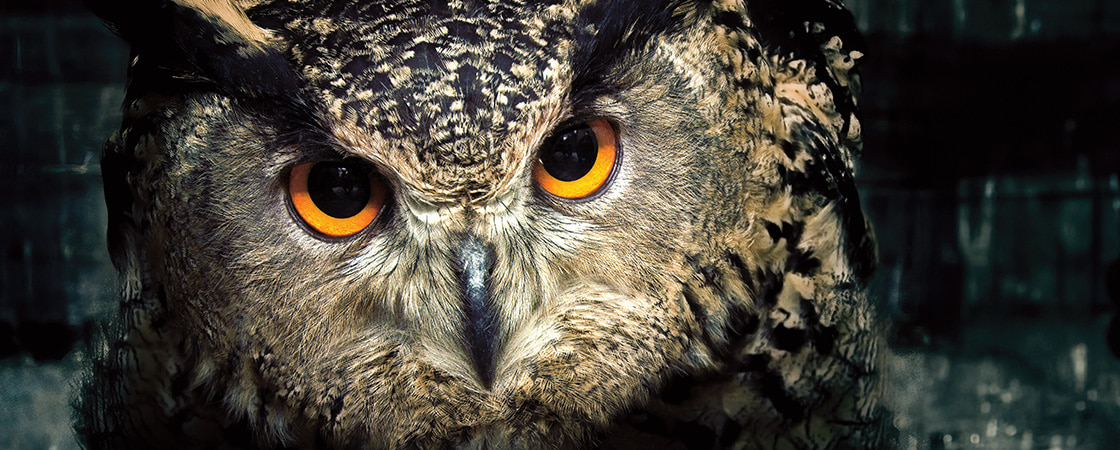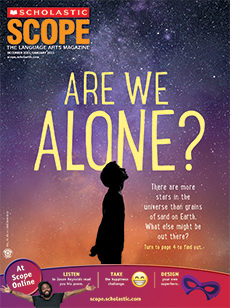The first time I saw the owl was the day we buried my grandfather. It was surprising for two reasons. First, because I’d never seen an owl before and knew how rare they were. And second, because my grandfather had been an avid collector of the animal his whole life. Paper weights, key hooks, tea bag holders—all in the shape of owls—adorned every surface of his small home in Chipping Sodbury. As he grew older, the house became overrun with owls, yet every birthday and Christmas he would still receive more. I don’t know whether he welcomed them at that point or whether he was just resigned to the fact it was all he’d ever be given.

The Owl
What is the mysterious bird outside the window trying to say?
Learning Objective: to make inferences in a work of short fiction, then continue the narrative in a sequel

Roy Waller/Alamy Stock Photo
The real-life owl landed right outside my bedroom window. Even though it was the middle of the night, I was awake, thinking about everything that had happened that day, my cheeks smeared with old tears.
Wha-woo. Wha-woo.
I heard the owl before I saw it. I got out of bed and pulled back the curtains, and there it was, on a branch of the old sycamore tree. Dad’s been going on at our neighbors to cut the tree down for years, because it stretches across our yard and blocks out the sunlight, but on that night, I was glad it was there.
The owl was the most beautiful bird I’d ever seen: small and squat—perhaps just a baby—with brown feathers that looked like they’d been dusted in snow. It sat there, staring at me with its gold-flecked eyes, content to let me watch it through the window. Then a car drove past, its headlights blazing, which spooked the owl away.
I wasn’t expecting to see the bird again, but it came back the next night and the one after that. It would announce its arrival by hooting its calming song, and then it would just stare at me, mimicking my movements as I tilted my head from side to side.
On the evening of the fourth day, I took a tin of my black Lab Misty’s dog food and put a couple of spoonfuls on the windowsill outside my bedroom. I didn’t know what owls ate (other than mice, but I didn’t have any of those) but thought I might be able to tempt it with some liver chunks in jelly. The owl didn’t appear that night though. I left the dog food on the windowsill for a week, waking up each morning to check if any had been eaten, but the owl never returned.

Life moved on. I went back to school and spent my weekends playing hockey and studying for my end-of-year exams. Over time, I forgot about the owl completely. Until one night last winter.
I was walking home after a hockey match. We’d played Yate High, who have been our rivals for years, and beat them 3-2, so I was bounding along, high on life. It wasn’t late, but at that time of year, the sky turns black early, and it was already dark and freezing cold. There’s a road not far from my house that locals call “the devil’s bend” because cars always whiz around it at a hundred miles an hour, and it’s a blind corner so they can’t see what’s coming. Mum always goes on about how careful I need to be when crossing that road, and I usually am. But that night, my mind was elsewhere, thinking about the winning goal we’d scored right in the final minutes of the game. I was just about to step out into the road when—
Wha-woo. Wha-woo.
I turned, and there it was: halfway up a spindly birch tree, with that steely look on its face. No sooner had I spotted the owl than a car zoomed around the corner, almost knocking me off my feet. My heart was racing and a wave of dizziness washed over me. I’d been about to cross that road. If the bird hadn’t stopped me . . .
I looked back. The owl was still on its branch, watching me with its gold-flecked eyes.
“Thank you,” I said, no more than a whisper.
It ruffled its feathers, cooed once more, and then flew off into the night.

Writing Prompt
Write a sequel in which the narrator sees the owl again. Your sequel could take place weeks, years, or even decades later. Don’t tell your readers everything—give them clues so they can draw inferences.
This story was originally published in the December 2023/January 2024 issue.
Close Reading, Critical Thinking, Skill Building
Essential Questions: How do we cope with the loss of a loved one?
1. PREPARE TO READ (10 MINUTES)
Preview Vocabulary (10 minutes)
Project the Google Slides version of Vocabulary Definitions and Practice on your whiteboard. Review the definitions and complete the activity as a class. Highlighted words: avid, bounding, resigned, spindly. Audio pronunciations of the words and a read-aloud of the definitions are embedded on the slides. Optionally, print the PDF version or share the slideshow link directly to your LMS and have students preview the words and complete the activity independently before class.
2. READ AND DISCUSS (45 MINUTES)
- Read the “Spotlight On” box on page 28 or at the top of the digital story page.
- For students’ first read, have them follow along as they listen to author Joseph Elliott read his story aloud. The audio read-aloud is located in the Resources tab in Teacher View and at the top of the story page in Student View.
- Have students reread and annotate the story independently. Here are some symbols you might have them use:
∞ = connection
⭐ = important
❓ = I don’t understand
💭 = “I’m thinking . . .” (add words and comments)
💙 = love this
(Some students may note the town name “Chipping Sodbury” and the narrator’s use of “Mum,” “tin,” and “going on at our neighbors” in their annotations. If they do not, prompt them to look for words, names, or expressions that reflect the fact that the author of the story is British.)
- Alternatively, have students complete a double-entry journal during their reread. In their journals or on a piece of paper, have students create a T-chart. In the left-hand column, have them record three to five lines that jump out at them or feel particularly meaningful. In the right-hand column, have them record their reactions to these lines through questions, comments, connections, or analysis. You can find both a print and a digital version of our Double-Entry Journal handout in the Resources tab.
- Divide students into groups to discuss their annotations or double-entry journals. Then reconvene as a whole group and pose the following questions, some of which may draw on students’ reading responses and group discussions. (If you prefer to have students answer these questions in writing, use the Featured Skill: Inference activity and Discussion Questions in the Resources tab.)
Inference Questions (15 minutes)
- What inferences can readers draw about the owl in this story and why it appears to the narrator? What makes you say so? Readers can infer that the owl in this story may be the narrator’s deceased grandfather. An owl—possibly a baby—appears outside the narrator’s window on the day of the grandfather’s funeral. The fact that the grandfather was an avid collector of owl items throughout his life is a hint that the owl might be the narrator’s grandfather reincarnated; perhaps he came back as an owl so it would be easy for his loved ones to recognize his presence, or simply because he always loved owls. You can infer that the grandfather first visits the narrator to comfort them and let them know his spirit lives on, and later appears to protect the narrator from being hit by a car.
- The narrator never comes right out and says, “I was sad that my grandfather died.” What lines in the story allow you to infer that the narrator was full of grief over their grandfather’s death? The line “Even though it was the middle of the night, I was awake, thinking about everything that had happened that day, my cheeks smeared with old tears” allows the reader to infer that the narrator was full of grief over their grandfather’s death. (The first line of the story makes clear that when the narrator says “everything that had happened that day,” the narrator is referring to the day of their grandfather’s funeral.)
- The narrator says, “Dad’s been going on at our neighbors to cut the tree down for years, because it stretches across our yard and blocks out the sunlight, but on that night, I was glad it was there.” Why was the narrator glad the sycamore tree was there that night? Readers can infer that the narrator was glad the sycamore tree was there because it provided the owl with a place to sit right outside the narrator’s bedroom window. The narrator describes the owl as the most beautiful bird they’d ever seen and was clearly grateful for the owl’s presence—not only, you can infer, because of the owl’s beauty, but also because of the connection between the owl and the narrator’s grandfather. You can infer that the owl’s visit brought the narrator comfort.
- Why does the narrator set dog food on the windowsill? Perhaps the narrator sets dog food on the windowsill because they want to care for the owl, and offering the owl dog food is all they can think to do. It’s also possible that the narrator hopes the dog food will be an incentive to the owl to continue its nightly visits.
Critical-Thinking Questions (5 minutes)
- Readers can infer that the owl in this story is the narrator’s grandfather, who has come back to comfort and protect the narrator. However, there is no proof of this. It’s possible that it was all a coincidence. What do you think the narrator believes and why do you say so? What do you think? Answers will vary.
- Why might the author of this story, Joseph Elliott, have made the choice to not make it clear whether the owl really was the narrator’s grandfather? Answers will vary. One possible answer is that by writing the story the way he did, Elliott puts the reader in the narrator’s position of not knowing for sure.
3. WRITE YOUR SEQUEL (60 MINUTES)
Have students use the Narrative Planner to help them to respond to the writing prompt on page 29 in the printed magazine and at the bottom of the digital story page:
Write a sequel in which the narrator sees the owl again. Your sequel could take place weeks, years, or even decades later. Don’t tell your readers everything—give them clues so they can draw inferences.
- Alternatively, have students choose a task from the Choice Board, a menu of culminating tasks. (Our Choice Board options include the writing prompt from the magazine, differentiated versions of the writing prompt, and additional creative ways for students to demonstrate their understanding of a story.)
- An entry form for the writing contest is available here to download.
CONNECTED READING
